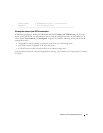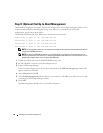
64 Network Configuration Guidelines
4
Select
Use the following IP address
and enter the IP address, subnet mask, and default gateway
addresses.
If using a DNS server
1
On the
Control Panel
, select
Network connections
or
Network and Sharing Center
. Then click
Manage network connections
.
2
Right-click the network connection you want to configure and select
Properties
.
3
On the
General
tab (for a local area connection) or the
Networking
tab (for all other connections),
select
Internet Protocol (TCP/IP)
, and then click
Properties
.
4
Select
Obtain DNS server address automatically
or enter the preferred and alternate DNS server IP
addresses and click
OK
.
If using a WINS server
NOTE: If you are using a DHCP server to allocate WINS server IP addresses, you do not need to add WINS
server addresses.
1
On the
Control Panel
, select
Network connections
.
2
Right-click the network connection you want to configure and select
Properties
.
3
On the
General
tab (for a local area connection) or the
Networking
tab (for all other connections),
select
Internet Protocol (TCP/IP)
, and then click
Properties
.
4
Select
Advanced
, then the
WINS
tab, and click
Add
.
5
In the
TCP/IP WINS server
window, type the IP address of the WINS server and click
Add
.
6
To enable use of the
Lmhosts
file to resolve remote NetBIOS names, select
Enable LMHOSTS
lookup
.
7
To specify the location of the file that you want to import into the
Lmhosts
file, select
Import
LMHOSTS
and then select the file in the
Open
dialog box
8
Enable or disable NetBIOS over TCP/IP.
If using Windows 2008 Core Version
On a server running Windows 2008 Core version, use the netsh interface command to configure the
iSCSI ports on the host server.
Linux Host Setup
If you are using a Linux host network, the following section provides a framework for preparing your
network for iSCSI.
To set up a Linux host network, you must configure the IP address and netmask of each iSCSI port
connected to the storage array. The specific steps depend on whether you are configuring TCP/IP using
Dynamic Host Configuration Protocol (DHCP) or configuring TCP/IP using a static IP address.


















